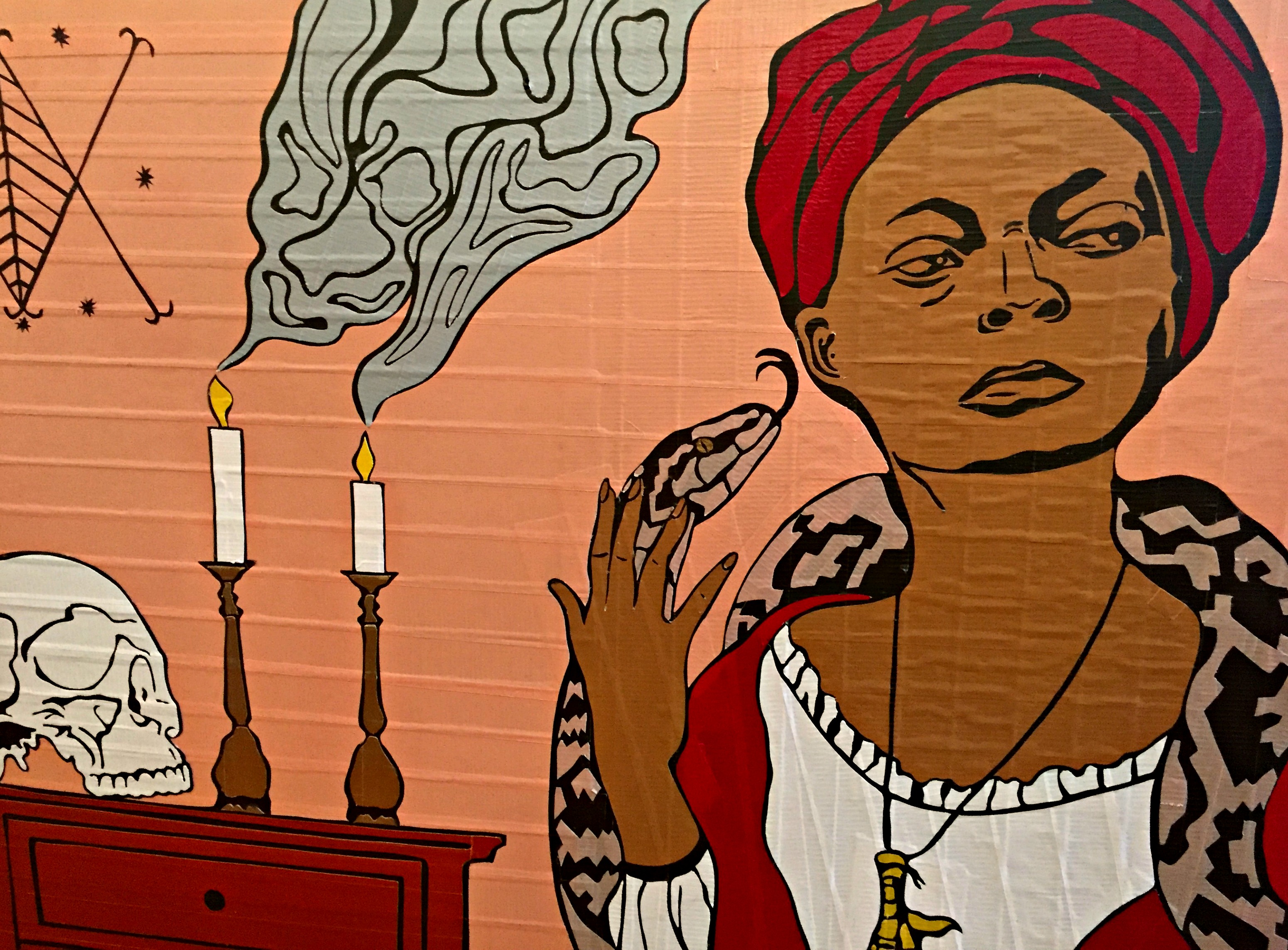
Artist Justin Lundgren with pieces from his newest work — pieces of history for the tricentennial. (Photo by: Kelley Crawford)
Who: Justin Lundgren
What: Visual artist
Where: His studio–where the walls and the floors are lined with his duct tape portraits that spotlight moments in New Orleans’ history and where his cat Cody wanders like an emperor.
Q: What drew you to using duct tape as a medium for your art?
JL: A couple of years ago I saw some examples of duct tape art on the web. Duct tape crafting became a big thing about 10 years ago — teenagers making wallets or fashioning their prom dresses out of duct tape — so now you can find different colors of the tape. Reds, blues, gold. I thought the art was really interesting. In its most simple form, I thought I could make a portrait out of duct tape. My experiments went well, and I kept doing it. There aren’t that many people around the world trying to make real tape art, something more than crafting, and I’d like to think I’m doing my part to show people that it’s a medium with real potential for artistic expression.
It’s a weird medium.The color pallet you get with duct tape is narrow and the colors are bold. I came to realize midway through this project that the medium is perfect for a pop art style.
Some of the portraits might take eight or nine hours to complete and some may take 30 hours. It really depends on how complicated it is and how many colors I’m trying to incorporate in the piece. The pieces I’ve been working on for this show at the Reynold’s Ryan Gallery take about 12-15 hours a piece, on average.
Q: Have you ever had any massive fails?
JL: It happens so many times, and it’s tragic. You really don’t know what you have until the very end. You’re layering the tape, usually on wood, steel, or glass, and then cutting it. Then you draw your image. Then you cut through and peel back the top layer. You’re revealing the colors underneath.
It’s always a big surprise at the end of the project, but you could have possibly invested 12 hours of your life, and when you peel back that last layer of duct tape, it could look awful. The colors may not go well together. The lines won’t match. Nothing is working well. That has happened.

Pieces for Justin Lundgren’s newest exhibit for the tricentennial. (Photo by: Kelley Crawford)
Q: You are also a physician, so how do art and being a physician come together or stay separate?
My day-to-day work as a physician is different, of course, than artwork. It’s a different feeling and process. The thing that brings the two together is storytelling. They’re both about listening to people’s’ stories and feeling empathic — either toward your patient of the subject of your art piece. Part of being a good physician is listening to people, hearing their stories, and then trying to find a direction of treatment based off of that. You have to have empathy to do it well.
For the art project, every subject tells a story about New Orleans’ history. For all of the subjects, I’ve tried to get into the heads of those subjects. I’m 62 pieces in; I have 30 more on my list, and if I let myself, I could probably do this project indefinitely. New Orleans’ history is so full. I’ve been reading so many books about New Orleans, and it really adds to my feelings about the city.
Q: When do you find that humans are at their most content?
I can’t speak for most humans, but I can speak for myself. For me, it is when I’m doing something that is meaningful and interesting. That could mean working on my family, my work as a doctor, or my art. It’s exciting to take something mundane like simple tape and fashion it into something that has meaning and life.
Justin Lundgren’s tape are will be on display at Reynolds Ryan Gallery (5333 Danneel Street). The opening for his exhibit will be on Thursday, August 23, 5-7PM. It will close on October 18th. For more information about Justin and his work, you can visit his website.
 NOLAbeings Multimedia artist Claire Bangser created NOLAbeings as a portrait-based story project that marries...
NOLAbeings Multimedia artist Claire Bangser created NOLAbeings as a portrait-based story project that marries...  Voodoo in New Orleans: Reviving history: New Orleans fortune telling This article takes a deep dive into the history of Voodoo in New Orleans, its hybridization with Catholicism, and its present-day place in the city's culture. The author visits fortune-tellers in the French Quarter, using their guidance as a tool for introspection rather than a deterministic predictor of the future. Through her experiences in New Orleans, the author feels a mystical connection to both the past and the future.
Voodoo in New Orleans: Reviving history: New Orleans fortune telling This article takes a deep dive into the history of Voodoo in New Orleans, its hybridization with Catholicism, and its present-day place in the city's culture. The author visits fortune-tellers in the French Quarter, using their guidance as a tool for introspection rather than a deterministic predictor of the future. Through her experiences in New Orleans, the author feels a mystical connection to both the past and the future. 